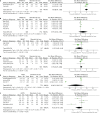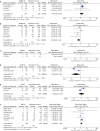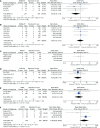Outcomes of Minimally Invasive Thyroid Surgery - A Systematic Review and Meta-Analysis
- PMID: 34456874
- PMCID: PMC8387875
- DOI: 10.3389/fendo.2021.719397
Outcomes of Minimally Invasive Thyroid Surgery - A Systematic Review and Meta-Analysis
Abstract
Purpose: Conventional thyroidectomy has been standard of care for surgical thyroid nodules. For cosmetic purposes different minimally invasive and remote-access surgical approaches have been developed. At present, the most used robotic and endoscopic thyroidectomy approaches are minimally invasive video assisted thyroidectomy (MIVAT), bilateral axillo-breast approach endoscopic thyroidectomy (BABA-ET), bilateral axillo-breast approach robotic thyroidectomy (BABA-RT), transoral endoscopic thyroidectomy via vestibular approach (TOETVA), retro-auricular endoscopic thyroidectomy (RA-ET), retro-auricular robotic thyroidectomy (RA-RT), gasless transaxillary endoscopic thyroidectomy (GTET) and robot assisted transaxillary surgery (RATS). The purpose of this systematic review was to evaluate whether minimally invasive techniques are not inferior to conventional thyroidectomy.
Methods: A systematic search was conducted in Medline, Embase and Web of Science to identify original articles investigating operating time, length of hospital stay and complication rates regarding recurrent laryngeal nerve injury and hypocalcemia, of the different minimally invasive techniques.
Results: Out of 569 identified manuscripts, 98 studies met the inclusion criteria. Most studies were retrospective in nature. The results of the systematic review varied. Thirty-one articles were included in the meta-analysis. Compared to the standard of care, the meta-analysis showed no significant difference in length of hospital stay, except a longer stay after BABA-ET. No significant difference in incidence of recurrent laryngeal nerve injury and hypocalcemia was seen. As expected, operating time was significantly longer for most minimally invasive techniques.
Conclusions: This is the first comprehensive systematic review and meta-analysis comparing the eight most commonly used minimally invasive thyroid surgeries individually with standard of care. It can be concluded that minimally invasive techniques do not lead to more complications or longer hospital stay and are, therefore, not inferior to conventional thyroidectomy.
Keywords: bilateral axillo-breast approach endoscopic thyroidectomy (BABA-ET); bilateral axillo-breast approach robotic thyroidectomy (BABA-RT); gasless transaxillary endoscopic thyroidectomy (GTET); minimally invasive video assisted thyroidectomy (MIVAT); retro-auricular endoscopic thyroidectomy (RA-ET); retro-auricular robotic thyroidectomy (RA-RT); robot assisted transaxillary surgery (RATS); transoral endoscopic thyroidectomy via vestibular approach (TOETVA).
Copyright © 2021 de Vries, Aykan, Lodewijk, Damen, Borel Rinkes and Vriens.
Conflict of interest statement
The authors declare that the research was conducted in the absence of any commercial or financial relationships that could be construed as a potential conflict of interest.
Figures








References
-
- Haugen BR, Alexander EK, Bible KC, Doherty GM, Mandel DJ, Nikiforov YE. 2015 American Thyroid Association Management Guidelines for Adult Patients With Thyroid Nodules and Differentiated Thyroid Cancer. The American Thyroid Association Guidelines Task Force on Thyroid Nodules and Differentiated Thyroid Cancer. Thyroid (2016) 26:1–133. 10.1089/thy.2015.0020 - DOI - PMC - PubMed
Publication types
MeSH terms
LinkOut - more resources
Full Text Sources
Research Materials
Miscellaneous

